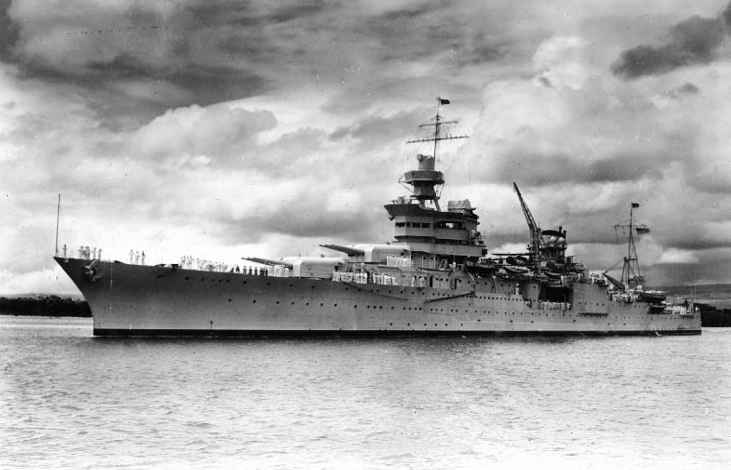 |
|
The USS Indianapolis was a Portland-class heavy cruiser (essentially, a mini-battleship) that played a pivotal role in World War II. The last days of this ship, which twice served as flagship of the Pacific's 5th Fleet, tell an absorbing story within the larger story of WWII. In late July 1945, the Indianapolis - Capt. Charles Butler McVay III commanding - made a high-speed run from California to the island of Tinian, near Guam. Tinian was a staging point for B-29 raids on Japan, and the Indianapolis was carrying components of Little Boy*, the first nuclear bomb ever used in warfare. The bomb essentials were delivered on July 26, 1945, and eleven days later, the Enola Gay dropped Little Boy on Hiroshima, Japan. After the delivery to Tinian, the Indianapolis sailed to Guam and was ordered to report to Leyte, one of the Philippine Islands, where she would prepare for the invasion of the Japanese mainland. To reach Leyte, Indianapolis would have to pass through an area known to be patrolled by at least two Japanese submarines despite the fact that she had no anti-submarine capability and would be given no destroyer escort. At 12:14 AM on July 30, the Japanese submarine I-58 fired six conventional torpedoes at Indianapolis. (I-58 also carried Kaiten "manned torpedoes" but didn't use them in this instance.) Two torpedoes hit Indianapolis, one of them igniting a secondary explosion that virtually blew the ship in half. She went down in twelve minutes, the last major US warship sunk in World War II. Of the Indianapolis's crew of 1,199 men (some sources say 1,196 or 1,197), some 300 went down with her. The remainder - approximately 900 officers and crew - went into the water. Most but not all had donned life jackets. Very few lifeboats were launched. For some reason, Indianapolis wasn't reported missing when she failed to arrive in Leyte, and the survivors stayed in the water for four days before a patrol aircraft spotted them on August 2. The patrolling bomber radioed in the sighting, and a Catalina PB-Y "flying boat" under the command of Lt. Adrian Marks was sent to the area. Marks, who could see sharks attacking the men, set down on the water - against policy - and began loading survivors. When the plane was full, he and his crew strapped others to the wings with parachute cord, trying to get as many sailors as possible out of the water and away from the sharks. The PB-Y crew rescued 56 men that day. The search for survivors continued until August 8. In all, 321 living men were pulled from the water. Four of those died soon afterward; only 317 of the ship's complement of almost 1,200 survived. The immensely successful movie Jaws has a scene in which Quint describes his ordeal as an Indianapolis survivor. The movie attributes most of the deaths to shark attacks, but no one knows how many men actually died from other causes, such as hypothermia, burns and other injuries from the shipboard explosion, or drowning. It is certain that sharks did kill many of the men in the water, but it's likely that many others were bitten only after dying from something else. One of the last survivors pulled from the ocean was Capt. McVay. He was subsequently convicted of negligence in the sinking of Indianapolis. Over 350 Navy ships were sunk in combat during WWII, but McVay was the only commander court-martialed for losing his vessel. He never got over the stigma of the conviction, and in 1968, he shot himself to death with his Navy sidearm. However, evidence eventually surfaced that showed the Navy knew there was a submarine risk in the area where Indianapolis was sailing but did not inform her commander.
The Navy managed to kill legislation in 1998 that would have cleared Captain McVay, but in July 2001, fifty-six years after the event, the Secretary of the Navy ordered that McVay be exonerated of any wrongdoing in the loss of the USS Indianapolis.
Copyright © 2004. All Rights Reserved. |


